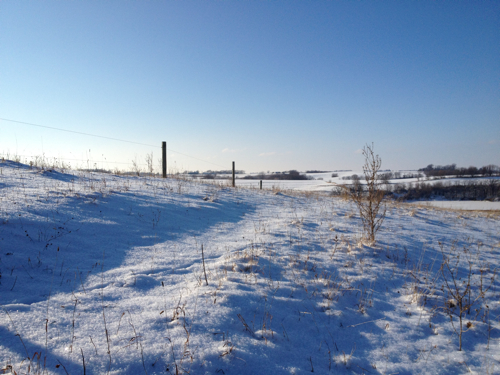 I'm still doing some of my bird surveys. And up until this week I was having a cheery time in the field, but now it's so incredibly silent. I can't believe this is the same spot that was chock full of bobolinks not so long ago. It's so strange to suddenly have a spot that was so vibrant with sound from breeding birds then switch to crickets then to chips of secretive migrating sparrows and then to nothing. It makes those hour long point counts feel like a long time. And though the landscape is beautiful, it's bleak and lonely...and not nearly as much fun to scramble under electric fences as the snow piles up.
I'm still doing some of my bird surveys. And up until this week I was having a cheery time in the field, but now it's so incredibly silent. I can't believe this is the same spot that was chock full of bobolinks not so long ago. It's so strange to suddenly have a spot that was so vibrant with sound from breeding birds then switch to crickets then to chips of secretive migrating sparrows and then to nothing. It makes those hour long point counts feel like a long time. And though the landscape is beautiful, it's bleak and lonely...and not nearly as much fun to scramble under electric fences as the snow piles up.

We've even been able to squeeze in another aerial waterfowl survey this week. Half the Mississippi River is frozen and reminds me a bit of a lunar landscape.

It snowed lightly while we were flying and the ending result made it seem as though we were flying right through a holiday card. I suggested the pilot attach a bright red nose to his plane and I'm not sure he found that nearly as funny as I did.

Swans fly like shimmering ghosts through the snow. The numbers of swans has dropped on the Mississippi and I'm not entirely sure that a majority of them are tundras. In early and mid November, I watched huge strings of swans fly over while I did my eagle surveys. I could hear their calls well before I saw them and knew they were tundra swans heading to the staging area on the Mississippi. Last week, I had smaller groups of swans using the exact same route, but listening to them, they were distinctly trumpeter swans. It's hard to tell the 2 apart in a plane at 100 miles an hour.

They are easy enough to count and id on the open water...

But much harder on ice and snow. This was as we were doing a high pass to see if there was enough open water to warrant a fly by. At fist, I though there are a few swans but not many...then I noticed how many of the whiter spots were moving on the ice, there were still hundreds of swans to be counted.

Canada geese are in large numbers, the biggest numbers I've seen all season. Considering all the waste corn in farm fields and all the places that have open water along the river, it's no surprise.

Here's part of a flock of bald eagles, there are at least 29 in this photo. I saw some very interesting behavior that I've not seen bald eagles do this week. Common mergansers are in huge numbers on Lake Pepin, but I was able to get a shot of them. Where ever we had huge flocks of mergansers, we had sizable flocks of bald eagles hunting them. It was crazy, we would have 10 bald eagles actively trying to nail a mergansers over open water. One spot was so active and dicey with mergansers and eagles, our pilot skillfully dodged around the flock. Our pilot doesn't like eagles to be directly over head because they can suddenly drop, through in a few thousand panicked ducks and barely freezing water and you have a dangerous situation. It was cool to get a fleeting glimpse of the behavior. Lake Pepin is so huge, it's not something easily viewed from shore. I'd be curious how successful this technique is and if any bald eagles ever end up drowning after catching a merganser on water. I know eagles are capable of swimming some distance to shore by paddling wings, but I don't think an eagle could make it from the center of Pepin.

Not as many ducks, but what a treat to get to view the bluffs in Minnesota and Wisconsin on either side of the Mississippi River. This was our last flight for ducks. I might do one ground survey next week, but that depends on if Pepin stays open. To view our waterfowl numbers check here. If this week's numbers aren't up yet, they will be up by Friday.
